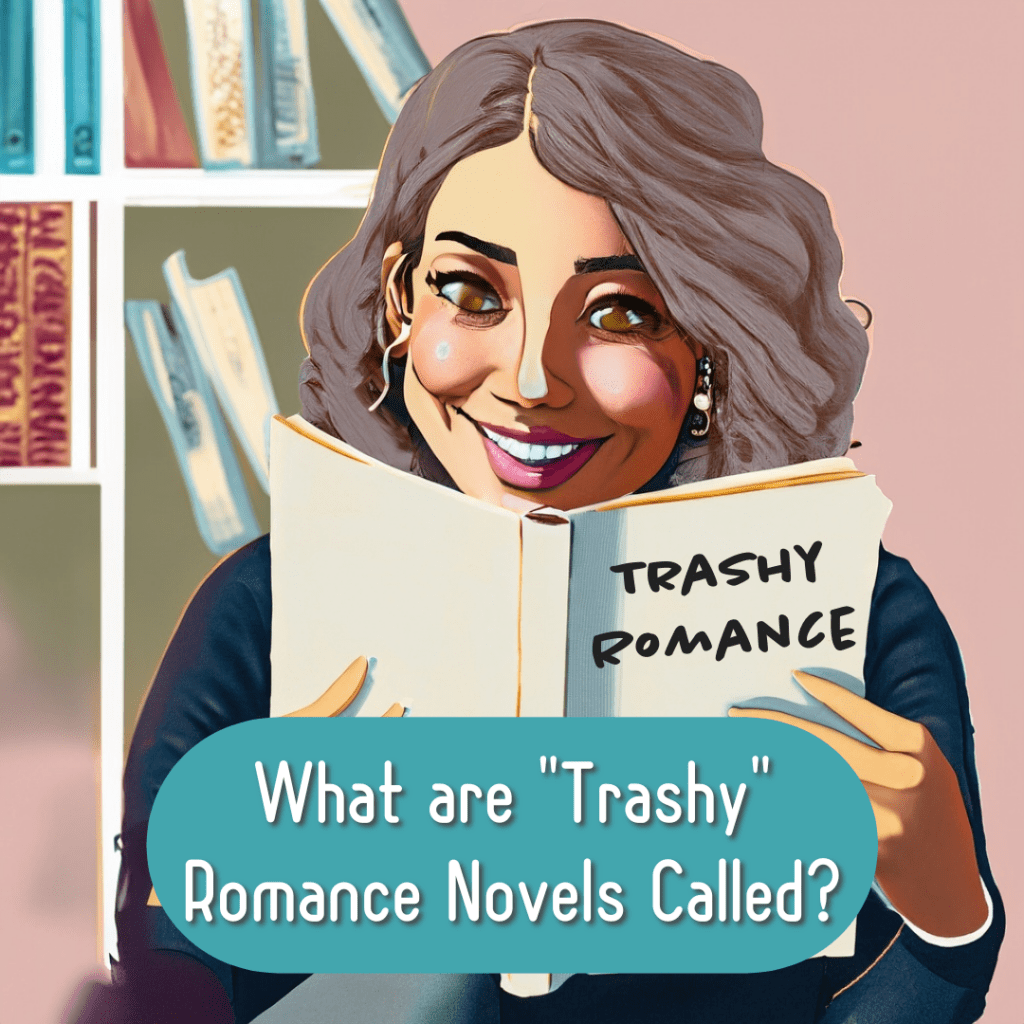What Are “Trashy” Romance Novels Called? Debunking Stereotypes and Exploring Romance Subgenres
 Romance novels have long been cherished for their ability to transport readers into worlds filled with passion, emotion, and profound connections. Within the genre, an abundance of subgenres exists, catering to diverse tastes and preferences. From contemporary tales of heartwarming love to paranormal encounters that transcend reality, romance novels offer a vast array of stories waiting to be discovered.
Romance novels have long been cherished for their ability to transport readers into worlds filled with passion, emotion, and profound connections. Within the genre, an abundance of subgenres exists, catering to diverse tastes and preferences. From contemporary tales of heartwarming love to paranormal encounters that transcend reality, romance novels offer a vast array of stories waiting to be discovered.
Have you ever noticed that when you mention a romance novel to someone, they often nod politely and talk about a book they’re reading? If you’re talking to someone who doesn’t mind confrontation, they might give you a defensive “I’m not into ‘trashy’ novels.”
And right there it is. “Trashy” romance novels. What are “trashy” romance novels? What are “trashy” romance novels called?
“Trashy” romance novels is a term that can evoke judgment and misunderstanding. Today, people are less likely to smack down any mention of romance novels than they were in the ’80s and ’90s. Back then, as a fledgling romance author, it was all I could do not to launch into an impassioned monologue on the virtues of the romance novel. Today, you stand a chance of finding a fellow romance novel fan. But, the judgment and misunderstanding are still present.
Let’s take a closer look at the diverse subgenres associated with this label, we can debunk stereotypes and highlight the multifaceted nature of love stories within the romance genre. What we need is a deeper understanding and appreciation for the rich tapestry of narratives that romance novels have to offer. So let’s talk about it.
The Subjective Nature of “Trashy”
The term “trashy” is inherently subjective when applied to romance novels. What one person may consider “trashy,” another might perceive as engaging and captivating. This subjectivity stems from the diversity of individual preferences and values. Each reader brings their unique set of tastes and experiences to the table, shaping their perception of what constitutes a “trashy” romance novel.
It is crucial to acknowledge and respect the vast range of tastes within the realm of romance novels. Readers connect with different aspects of storytelling, characters, and themes based on their personal preferences. Judging or dismissing a romance novel as “trashy” based on preconceived notions undermines the value and diversity of love stories.
As readers, we have the power to foster an inclusive and open-minded environment within the romance community. By embracing diverse tastes and avoiding judgment, we can create space for discussion, exploration, and the celebration of the many facets of romance novels and their appeal.
Popular Romance Subgenres
The romance genre offers a vast assortment of subgenres, each with its unique characteristics and appeal. These subgenres cater to diverse reader preferences, ensuring there is a love story for everyone to enjoy.
Subgenres Associated with Explicit Content or Labeled as “Trashy”
- Erotica: Known for its focus on explicit sexual content, erotica delves into the realm of passionate encounters and explores the depths of human desire. It appeals to readers seeking intense, uninhibited experiences within their love stories.
- Steamy Romance: Within the realm of steamy romance, readers encounter narratives that contain sensual or explicit scenes. However, these subgenres also emphasize emotional connections and character development, adding depth and complexity to the storylines.
- Bad Boy/Rich Alpha Male Romance: This subgenre places the spotlight on alpha male protagonists who exude charisma, dominance, and sometimes rebelliousness. Readers are drawn to the allure of forbidden or intense relationships, where strong emotions collide and ignite the pages.
- Paranormal Romance: Combining elements of the supernatural or fantastical with love stories, paranormal romance invites readers into a world where vampires, werewolves, witches, or other mystical beings coexist with human protagonists. These narratives often intertwine sensual or explicit content with captivating paranormal elements.
By highlighting these subgenres, we offer an understanding of the diverse storytelling within the romance genre. It’s important to note that while some of these subgenres may be associated with explicit content or labeled as “trashy,” their appeal lies in their ability to transport readers to captivating worlds, explore deep emotions, and celebrate the complexities of human, and sometimes otherworldly, relationships.
Challenging Stereotypes
Romance novels often face unwarranted stigma when labeled as “trashy.” This negative perception can undermine the genre’s true diversity, value, and impact. By dismissing romance novels based on stereotypes, readers miss out on the wide range of storytelling, emotional depth, and societal themes present within the genre.
It’s essential to challenge the notion that an entire genre can be reduced to being “trashy” based on preconceived notions. Romance novels explore a wide array of themes, including love, personal growth, overcoming challenges, and societal issues. They offer rich character development, intricate plotlines, and thought-provoking narratives that resonate with readers on a deep emotional level.
Dismissing romance novels without exploring their diversity neglects the many voices, perspectives, and experiences they encompass. From contemporary romance to historical fiction, LGBTQ+ love stories to multicultural narratives, romance novels showcase the complexity of human relationships and the power of love in all its forms.
Romance Novels on the Big (and Small) Screen
Romance novels have long held a special place in the hearts of readers, captivating us with their tales of passion, emotion, and profound connections. But the magic doesn’t stop on the pages of a book. Love stories have found their way onto the big screen, enchanting audiences worldwide with cinematic adaptations that bring these beloved narratives to life.
When a cherished romance novel makes its way to the big screen, it’s an exhilarating experience for both avid readers and movie enthusiasts alike. The transition from page to screen presents a unique opportunity to see beloved characters come alive, settings unfold in vibrant detail, and emotions conveyed through captivating performances. These adaptations not only entertain but also offer a new dimension to the stories we hold dear.
Over the years, many romance novels have made their mark on the silver screen, enchanting audiences with their heartfelt narratives. From timeless classics to contemporary gems, these adaptations have become beloved cinematic experiences that capture the essence of love and leave a lasting impact.
One such example is Jane Austen’s iconic “Pride and Prejudice,” which beautifully portrays the enduring love story of Elizabeth Bennet and Mr. Darcy. Since 1938 there have been 17 film and television adaptations of “Pride and Prejudice.” From stunning visuals to compelling performances, each has offered a heart-capturing interpretation of Austen’s novel.
Another noteworthy adaptation is Nicholas Sparks’ “The Notebook,” a heart-wrenching tale of love, loss, and second chances. This poignant story brought to life by Ryan Gosling and Rachel McAdams touched the hearts of millions and became a beloved romance classic.
While movies have their allure, television shows have also embraced the magic of romance novels, offering viewers a chance to immerse themselves in captivating love stories over multiple episodes and seasons. Shows like “Outlander,” based on Diana Gabaldon’s series, transport us through time and space, intertwining historical events and passionate romance in a mesmerizing blend.
No exploration of romance novel adaptations would be complete without mentioning E.L. James and her groundbreaking “Fifty Shades” series. With its blend of steamy passion and captivating storytelling, the “Fifty Shades” trilogy pushed boundaries and ignited conversations around love, desire, and consent.
While the series has sparked both praise and controversy, there’s no denying its impact on the romance genre and its successful transition to the big screen. The film adaptations brought Anastasia Steele and Christian Grey’s intense relationship to life, captivating audiences worldwide and sparking a renewed interest in exploring the complexities of love, power dynamics, and personal boundaries. The “Fifty Shades” series serves as a testament to the ability of romance novels and their adaptations to provoke thought, challenge societal norms, and invite readers and viewers to engage in discussions about love, sexuality, and the nature of relationships.
Cold, Hard Facts: The Dominance of Romance Novels
We get it. We can wax poetic about the romance genre all we want but feelings and warm fuzzies won’t convince you. Let’s talk numbers.
When it comes to the publishing industry in 2023, romance novels reign supreme, and the statistics speak for themselves. Love stories have captured the hearts of readers worldwide, making them the highest-earning genre of fiction. In fact, romance novels generated a staggering $1.44 billion in revenue, showcasing their undeniable popularity and widespread appeal.
The demand for romance novels is evident in the impressive sales figures. Over the past 12 months alone, a whopping 19 million printed romance novels were sold. Even more remarkable is the fact that sales of printed romance novels saw a remarkable 36% increase compared to the previous year, indicating a growing appetite for these captivating tales of love.
In terms of growth, romance novels were the fastest-growing genre of fiction in 2022, contributing to an impressive 66% of the overall growth in adult fiction. It’s clear that readers are turning to romance novels to experience the emotional rollercoaster and captivating narratives that make them such compelling reads.
Romance novels have secured their position as the most popular genre of books sold in the US, with a staggering 32 million print copies sold in 2022. This widespread popularity isn’t limited to a specific age group but extends across various demographics. Readers aged 18 to 34 particularly embrace romance novels, finding solace and excitement in their pages.
Interestingly, readers in the 18 to 34 age group have a higher preference for buying romance novels in print rather than in ebook format. This preference not only reflects the enduring charm of physical books but also presents publishers with a higher profit margin. It’s a win-win situation that underscores the profitability and enduring appeal of romance novels.
While romance novels dominate the publishing industry, it’s worth noting the other notable genres that follow. Crime/thriller, religious and inspirational, science fiction and fantasy, and horror genres have all made their mark, but none quite match the earning power and popularity of romance novels.
Final Thoughts
It’s important to approach romance novels with an open mind, recognizing the genre’s diversity and potential for meaningful storytelling. Romance novels encompass a wide range of subgenres, themes, and narratives, catering to various tastes and preferences. They offer not only passionate love stories but also complex characters, thought-provoking themes, and emotional depth. By immersing ourselves in the world of romance novels, we can discover new perspectives, explore the complexities of relationships, and find solace, excitement, and connection within their pages.
With over $1.44 billion in revenue, 19 million printed romance novels sold in the last 12 months, and a remarkable 36% increase in sales compared to the previous year, romance novels have proven their enduring popularity and profitability. They were the fastest-growing genre of fiction in 2022, contributing to 66% of adult fiction growth. Romance novels also topped the charts as the most popular genre of books sold in the US, with over 32 million print copies sold in 2022.
In the ever-evolving landscape of the publishing industry, romance novels stand tall as a testament to their enduring popularity and the profound impact they have on readers worldwide. Let’s celebrate that diversity, embrace the stories, and find inspiration, joy, and connection within the pages of these captivating love stories.
And to answer that question: What are “trashy” romance novels called? In our opinion, they are exceptional.
